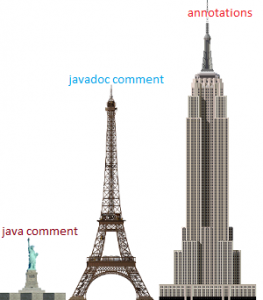

OK, so let’s dive into this in a bit more detail. Type=class, authenticationType=CONTAINER), demonstrates the key features of namely, that the composite annotation is correctly “expanded” into a and a annotation, and the “regular” annotation is still picked up. Type=class, authenticationType=CONTAINER), annotations from mappedName=, description=, name=, When run, it should produce output similar to the following Retrieving annotations from mappedName=, description=, name=,

Log.info(Arrays.toString(annotatedElements.getAnnotations(OtherAnnotatedAnnotation.class))) Let us discuss both the scenario to a certain depth. Documented is a meta-annotation (an annotation applied to other annotations) provided in java.lang. Log.info("Retrieving annotations from OtherAnnotatedAnnotation.class") To ensure that our custom annotations are shown in the documentation, we use Documented annotation to annotate our custom annotations. Log.info(Arrays.toString(annotatedElements.getAnnotations(AnnotatedAnnotation.class))) Log.info("Retrieving annotations from AnnotatedAnnotation.class") get a configured instance of the AnnotatedElements interfaceĪnnotatedElements annotatedElements =. The AtCompositeDemo class included in the project basically looks like this: public class AtCompositeDemo So is not (yet) drop-in magic – you will need to explicitly call the AnnotatedElements interface from your code. Composite annotations are instead supported via an AnnotatedElements interface, which provides all the familiar annotation-related methods, and “unpacks” registered composite annotations to their “leaf” types. Just to dispel any misconceptions up front: here be no bytecode weaving or other runtime magic, so does not affect the semantics of the “regular” AnnotatedElement methods 1. Well, it took me rather longer than the couple of days it would probably have taken a developer of Wilfred’s skill, but finally is here! Sort-of “macro annotatations” for Java, if you like.Ī thought that has presumably also occurred to many frequent users of Hibernate, JAXB or other annotation-heavy frameworks.
Java annotations software#
Compile-time and deployment-time processing Software tools can process annotation information to generate code, XML files, and so forth. Defining binary file formats in Preon requires quite a lot of fairly repetitive sets of annotations, and during a chat after the talk Wilfred mentioned (in fact, he blogged about it) how much more convenient it would be if one could just define “shortcuts”: = "AGENT")įor = instance – and use those instead. Annotations have a number of uses, among them: Information for the compiler Annotations can be used by the compiler to detect errors or suppress warnings.

Runtime instructions : Some annotations are available to be examined at runtime.Build-time instructions : Software tools can process annotation information to generate code, XML files, and so forth.Compiler instructions : Annotations can be used by the compiler to detect errors or suppress warnings.The important use of Annotations such as: Classes, methods, variables, parameters and packages can be annotated in Java. So Annotations are metadata for source code. Java annotations are used to provide meta data for the Java code, although they are not a part of the program itself.


 0 kommentar(er)
0 kommentar(er)
